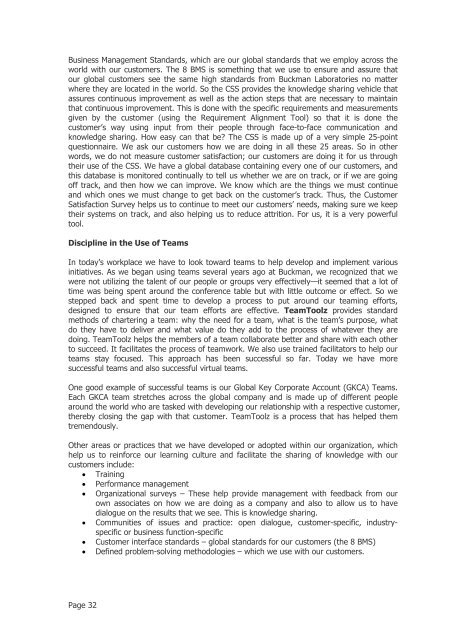Knowledge Management: From Brain to Business (PDF 5.5 - Asian ...
Knowledge Management: From Brain to Business (PDF 5.5 - Asian ...
Knowledge Management: From Brain to Business (PDF 5.5 - Asian ...
Create successful ePaper yourself
Turn your PDF publications into a flip-book with our unique Google optimized e-Paper software.
<strong>Business</strong> <strong>Management</strong> Standards, which are our global standards that we employ across the<br />
world with our cus<strong>to</strong>mers. The 8 BMS is something that we use <strong>to</strong> ensure and assure that<br />
our global cus<strong>to</strong>mers see the same high standards from Buckman Labora<strong>to</strong>ries no matter<br />
where they are located in the world. So the CSS provides the knowledge sharing vehicle that<br />
assures continuous improvement as well as the action steps that are necessary <strong>to</strong> maintain<br />
that continuous improvement. This is done with the specific requirements and measurements<br />
given by the cus<strong>to</strong>mer (using the Requirement Alignment Tool) so that it is done the<br />
cus<strong>to</strong>mer’s way using input from their people through face-<strong>to</strong>-face communication and<br />
knowledge sharing. How easy can that be? The CSS is made up of a very simple 25-point<br />
questionnaire. We ask our cus<strong>to</strong>mers how we are doing in all these 25 areas. So in other<br />
words, we do not measure cus<strong>to</strong>mer satisfaction; our cus<strong>to</strong>mers are doing it for us through<br />
their use of the CSS. We have a global database containing every one of our cus<strong>to</strong>mers, and<br />
this database is moni<strong>to</strong>red continually <strong>to</strong> tell us whether we are on track, or if we are going<br />
off track, and then how we can improve. We know which are the things we must continue<br />
and which ones we must change <strong>to</strong> get back on the cus<strong>to</strong>mer’s track. Thus, the Cus<strong>to</strong>mer<br />
Satisfaction Survey helps us <strong>to</strong> continue <strong>to</strong> meet our cus<strong>to</strong>mers’ needs, making sure we keep<br />
their systems on track, and also helping us <strong>to</strong> reduce attrition. For us, it is a very powerful<br />
<strong>to</strong>ol.<br />
Discipline in the Use of Teams<br />
In <strong>to</strong>day’s workplace we have <strong>to</strong> look <strong>to</strong>ward teams <strong>to</strong> help develop and implement various<br />
initiatives. As we began using teams several years ago at Buckman, we recognized that we<br />
were not utilizing the talent of our people or groups very effectively—it seemed that a lot of<br />
time was being spent around the conference table but with little outcome or effect. So we<br />
stepped back and spent time <strong>to</strong> develop a process <strong>to</strong> put around our teaming efforts,<br />
designed <strong>to</strong> ensure that our team efforts are effective. TeamToolz provides standard<br />
methods of chartering a team: why the need for a team, what is the team’s purpose, what<br />
do they have <strong>to</strong> deliver and what value do they add <strong>to</strong> the process of whatever they are<br />
doing. TeamToolz helps the members of a team collaborate better and share with each other<br />
<strong>to</strong> succeed. It facilitates the process of teamwork. We also use trained facilita<strong>to</strong>rs <strong>to</strong> help our<br />
teams stay focused. This approach has been successful so far. Today we have more<br />
successful teams and also successful virtual teams.<br />
One good example of successful teams is our Global Key Corporate Account (GKCA) Teams.<br />
Each GKCA team stretches across the global company and is made up of different people<br />
around the world who are tasked with developing our relationship with a respective cus<strong>to</strong>mer,<br />
thereby closing the gap with that cus<strong>to</strong>mer. TeamToolz is a process that has helped them<br />
tremendously.<br />
Other areas or practices that we have developed or adopted within our organization, which<br />
help us <strong>to</strong> reinforce our learning culture and facilitate the sharing of knowledge with our<br />
cus<strong>to</strong>mers include:<br />
• Training<br />
• Performance management<br />
• Organizational surveys – These help provide management with feedback from our<br />
own associates on how we are doing as a company and also <strong>to</strong> allow us <strong>to</strong> have<br />
dialogue on the results that we see. This is knowledge sharing.<br />
• Communities of issues and practice: open dialogue, cus<strong>to</strong>mer-specific, industryspecific<br />
or business function-specific<br />
• Cus<strong>to</strong>mer interface standards – global standards for our cus<strong>to</strong>mers (the 8 BMS)<br />
• Defined problem-solving methodologies – which we use with our cus<strong>to</strong>mers.<br />
Page 32
















